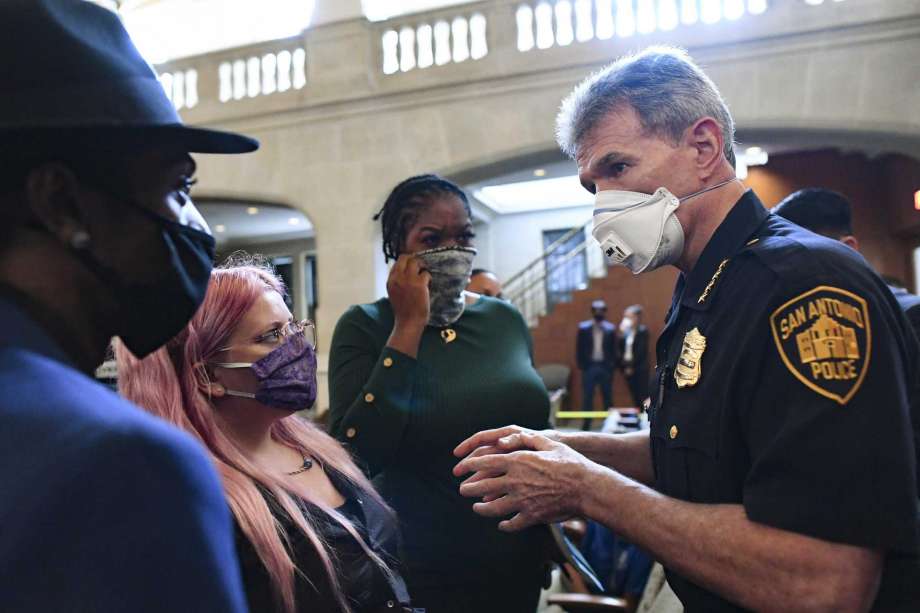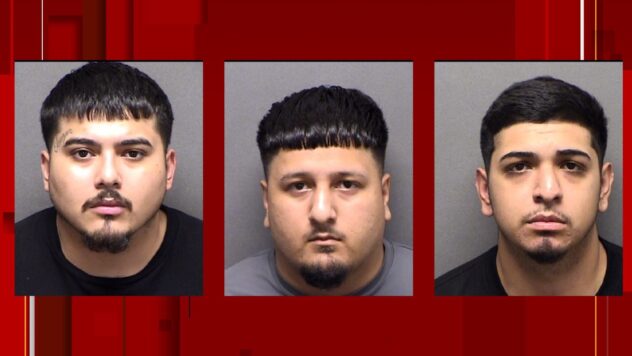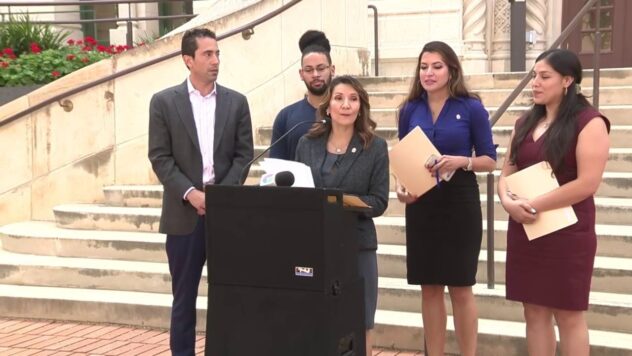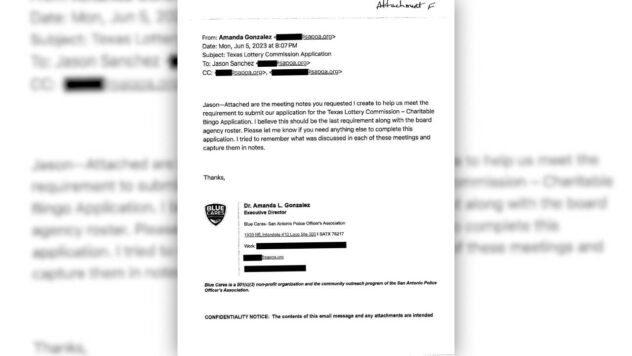SAPD Chief McManus was grilled at a public safety hearing. Here are 5 takeaways.

-
San Antonio Police Chief William McManus addresses issues of a police union that gets many fired police officers reinstated as he speaks with Pharaoh Clark, left, Ghouli Blooms and Jourdyn Parks after a San Antonio City Council Public Safety Committee meeting on Thursday, June 18, 2020.
San Antonio Police Chief William McManus addresses issues of a police union that gets many fired police officers reinstated as he speaks with Pharaoh Clark, left, Ghouli Blooms and Jourdyn Parks after a San
Photo: Billy Calzada, Staff / San Antonio Express-News
San Antonio Police Chief William McManus addresses issues of a police union that gets many fired police officers reinstated as he speaks with Pharaoh Clark, left, Ghouli Blooms and Jourdyn Parks after a San Antonio City Council Public Safety Committee meeting on Thursday, June 18, 2020.
San Antonio Police Chief William McManus addresses issues of a police union that gets many fired police officers reinstated as he speaks with Pharaoh Clark, left, Ghouli Blooms and Jourdyn Parks after a San
Photo: Billy Calzada, Staff / San Antonio Express-News
San Antonio Police Chief William McManus faced questions — and some fiery comments — from city officials and members of the public Thursday during a community listening session.
The meeting, hosted by the City Council Public Safety Committee, was the second of three sessions intended to gather feedback on policing in the city after George Floyd’s death in Minneapolis focused national attention on the subject.
On ExpressNews.com: San Antonio activists call on City Council to improve psych exams for police, repeal local laws
McManus briefed the committee on the department’s recruitment practices, training and demographics.
Each committee member was allotted 10 minutes to ask questions before the floor was opened to residents.
Here’s what we learned from the listening session:
– Most police officers in San Antonio don’t live in the city.
Councilwomen Jada Andrews-Sullivan asked McManus how many SAPD officers are San Antonio residents.
“The greater percentage of them are not,” the chief replied. “I don’t know the percentage offhand but the greater percentage are not.”
Deputy City Manager Maria Villagomez later confirmed that only 46 percent of the force actually lives within city limits.
– The percentage of African American officers in the department decreased from 2005 to 2020.
In 2005, the department demographics were 48 percent Hispanic, 46 percent White, 6 percent African American and 1 percent Other.
In 2020, the demographics are 55 percent Hispanic, 38 percent White, 5 percent African American, and 2 percent Other.
“We took a one percentage drop in African American positions but I would say that we made up for that one percent drop by jumping a percent — from one percent to two percent — in the Other category,” McManus said.
– San Antonio police receive double the amount of training as the state requires.
In response to questioning from Councilman Clayton Perry, SAPD officials noted that the state requires about 600 hours of training for cadets. The department provides about 1,300 hours of training — 32 weeks — of instruction for cadets.
Officials said that standard continues once cadets graduate. While Texas requires 40 hours on-the-job training every two years, San Antonio police receive 40 hours each year.
– Councilwoman Ana Sandoval examined the department’s current gender split: 89 percent male and 11 percent female.
Sandoval noted police officers represent some of the highest-paid city employees.
“If our best jobs — the one’s that offer the highest wages — aren’t recruiting women effectively and we’re not sharing that wealth with them, we are going to see that in the city of San Antonio, the women who work here will on average earn less than a man,” she said.
– The first member of the public to address the meeting received a round of applause from the audience after pointing to an “embarrassing statistic” and a reinstated officer.
The man alluded to a 2017 Washington Post investigation into police misconduct found that San Antonio had the highest rate (70 percent) of fired police officers reinstated due to collective-bargaining arbitration clauses.
The speaker then referenced the case of Emanuel Keith, an SAPD officer fired in 2019 for leaving threatening voicemails to his mistress.
On Thursday, the community member read several of those voicemails — including “I could choke the life out of you” — to McManus and the committee. Keith’s indefinite suspension was overturned in arbitration and he will soon return to the force.
“If these are the kind of officers the SAPOA wishes to defend, they should have the decency of letting the public know why arbitration would side with them. We need transparency to fix a system that so consistently sides with officers like Emmanuel Keith,” the speaker said.
Several speakers later, another community member brought up the police union again. The woman implored city council members to remove provisions in the collective-bargaining agreement that limit investigations into police misconduct.
“If you continue to be silent, to be inactive,” she said, “you are just as responsible for our broken, dead bodies on the streets as these cops that are killing us.”
















